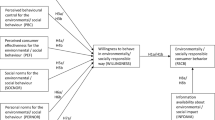Abstract
This paper attempts to investigate the aspiration for owning a car among young adults in Bangalore city in India. The data set used for the analysis is from a primary revealed preference survey of about 750 college students, who will be in workforce in near future. Apart from the usual set of personal and household socio-demographic information, the survey gathered the respondents’ perceptions of status, peer influence, car use, image of public modes, and miscellaneous attributes. The responses to these attitudinal questions are recorded on a five-point Likert-type scale. Through factor analysis, the responses are reduced to a number of factors that could reasonably explain the variability in the responses. Subsequently, a binary logit model is estimated for relating the attitudinal factors to car ownership decision in presence of several socio-demographic indicators. The main findings of the econometric analysis include, among others, the relatively higher propensity of the individuals who are qualified above bachelor’s degree to own a car; the direct association between participation in out-door sports and car ownership; and the positive influence of the factor relating the happiness derived from car use on car ownership, and that shows the rising aspiration for owning a car among youths.
Similar content being viewed by others
References
Bhat CR, Pulugurta V (1998) A comparison of two alternative behavioral choice mechanisms for household auto ownership decisions. Transpn Res.-B 32(1):61–75
Bhat CR, Srinivasan S, Guo JY (2002) Activity-based travel-demand analysis for metropolitan areas in Texas: data sources, sample formation, and estimation results, Report No. 4080–3. Centre for Transportation Research. The University of Texas at Austin, USA
Census of India, Houses, Household Amenities, and Assets, (2011). http://www.devinfolive.info/censusinfodashboard/website/index.php/pages/assets/total/car_jeep_van/IND. Accessed 05 May 2015
Chen RB, Gehrke SR, Jang Y, Liu JH, Clifton KJ (2013) Exploring residential tenure and housing type decisions and household activity engagement. Transp Res Rec 2344:68–78
Choo S, Mokhtarian PL (2004) What type of vehicle do people drive? The role of attitude and lifestyle in influencing vehicle type choice. Transp Res A 38:201–222.
Costello AB, Osborne JW (2009) Best practices in exploratory factor analysis: four recommendations for getting the most from your analysis. Pan-Pac Manag Rev 12(2):131–146
Cullinane S (2002) The relationship between car ownership and public transport provision: a case study of Hong Kong. Transp Policy 9(1):29–39
Ewing R, Haliyur P, Page GW (1994) Getting around a traditional city, a suburban planned unit development, and everything in between. Transp Res Rec 1466:53–62
Federal Highway Administration (2011) FHWA drivers’ license statistic. http://www.fhwa.dot.gov/policyinformation/quickfinddata/qfdrivers.cfm. Accessed 25 Sept 2011
Federal Highway Administration (2012) NHTS publications. http://nhts.ornl.gov/publications.shtml. Accessed 13 Mar 2012
Frandberg L, Vilhelmson B (2011) More or less travel: personal mobility trends in the Swedish population focusing gender and cohort. J Transp Geogr 19(6):1235–1244
Handy SL, Smart (2005) Growth and the transportation-land use connection: what does the research tell us? Int Reg Sci Rev 28(2):146–167
Ipsita B, Walker JL, Deakin EA, Kanafani A (2010) New vehicle choice in india: household choice among motorized vehicle segments. In Proceedings of the 12th WCTR, July 11–15, 2010, Lisbon, Portugal
Ipsita B (2011) Automobility in India: a study of car acquisition and ownership trends in the city of Surat. Ph.D. thesis, Civil and Environmental Engineering, University of California, Berkeley
Kruse P (2009) Ein Kultobjekt wird abgewrackt. GDI Impuls Wissensmagazin fu¨r Wirtschaft, Gesellschaft, Handel 1:13–18
Kuhnimhof TG et al (2012) Men shapes a downward trend in car use among young adults—evidence from six industrialized countries. Transp Rev 32(6):761–779
Kuhnimhof TG, Bu¨hler R, Dargay J (2011) A new generation: travel trends among young Germans and Britons. Transp Res Rec 2230:58–67
Lucas K, Le Vine S (2009) The car in British society, Working Paper 2: Literature Review
Metropolitan Washington Council of Governments (2010) Survey shows significant shift in daily travel pattern. http://www.mwcog.org/news/press/detail.asp?NEWS_ID=437. Accessed 14 Feb 2012
Nelson NM et al (2008) Active commuting to school: how far is too far? Int J Behav Nutr Phys Act 5(1):1
Ni MC (2008) Motorization, vehicle purchase and use behaviour in China: a Shanghai survey. Ph.D. thesis, University of California, Davis
Noble B (2005). Why are some young people choosing not to drive? In: European Transport Conference, Strasbourg, France
Rajamani J, Bhat CR, Handy S, Knaap G, Song Y (2003) Assessing impact of urban form measures on non-work trip mode choice after controlling for demographic and level-of-service effects. Transp Res Rec 1831:158–165
Ruud A, Nordbakke S (2005) Decreasing driving license rates among young people—consequences for local public transport. In: European Transport Conference, Strasbourg, France
Simons D et al (2013) Factors influencing mode of transport in older adolescents: a qualitative study. BMC Public Health 13(1):323
Tabachnick BG, Fidell LS (2001) Using multivariate statistics. Allyn and Bacon, Boston
UN-Habitat (2012) State of the Urban Youth, India. http://www.esocialsciences.org/General/A201341118517_19.pdf. Accessed 05 May 2015
Van Acker V, Witlox F (2010) Car ownership as a mediating variable in car travel behaviour research using a structural equation modelling approach to identify its dual relationship. J Transp Geogr 18:65–74
Van Dyck D et al (2010) Criterion distances and correlates of active transportation to school in Belgian older adolescents. Int J Behav Nutr Phys Act 7(1):87
Verma M (2014) Growing car ownership and dependence in India and its policy implications. Case Stud Transp Policy. doi:10.1016/j.cstp.2014.04.004
Acknowledgements
The authors thank the management of academic institutes, M S Ramaiah Institute of Technology, M S Ramaiah Dental College, M S Ramaiah College of Arts, Science and Commerce, and MS Ramaiah College of Law, for allowing us to conduct survey at their institutes. The authors acknowledge the opportunity to present the research work that forms the basis of this article at the 3rd Conference of the Transportation Research Group of India held at Kolkata (India) from 17–20 December, 2015.
Author information
Authors and Affiliations
Corresponding author
Rights and permissions
About this article
Cite this article
Verma, M., Manoj, M. & Verma, A. Analysis of Aspiration for Owning a Car Among Youths in a City of a Developing Country, India. Transp. in Dev. Econ. 3, 7 (2017). https://doi.org/10.1007/s40890-017-0037-x
Received:
Accepted:
Published:
DOI: https://doi.org/10.1007/s40890-017-0037-x




